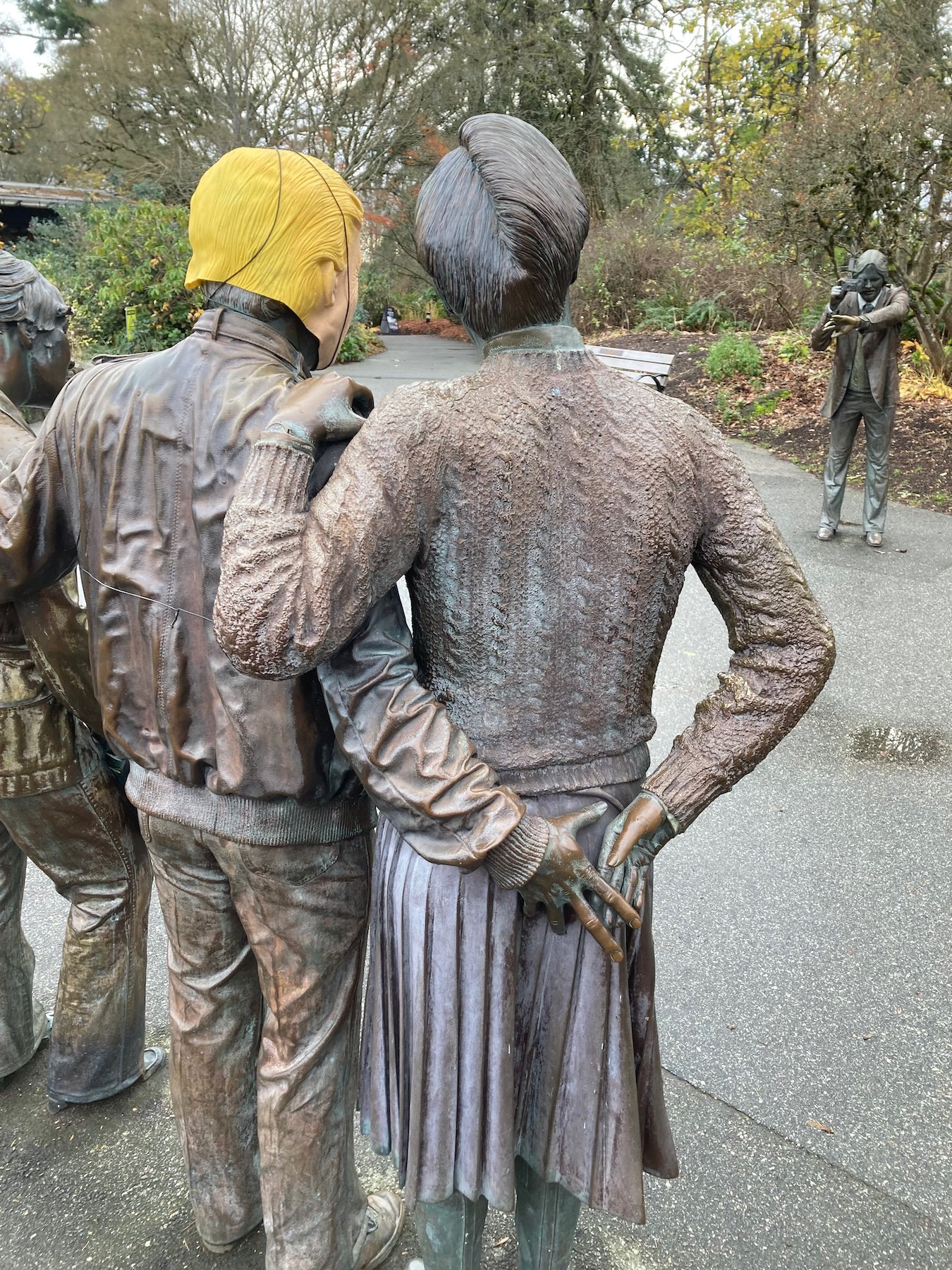Project Against Sexual Harassment
mixed media
2024
J. Seward Johnson Jr.
Bronze, 1984; gift of the artist.
Queen Elizabeth Park, Vancouver.
Photo Session (1984), by Seward Johnson (1930-2020), is a 4-part life-size figurative bronze sculptural installation in Queen Elizabeth Park in Vancouver, BC.
Seward Johnson (1930-2020) was an heir to the Johnson & Johnson Pharmaceutical fortune. His independent wealth allowed him, from 1974, to maintained a sizeable sculpture studio and foundry in Princeton, NJ, where he produced, with a large staff, a number of life-size figurative bronze sculptures, sometimes in multiple copies, cast from living models. These works were often gifted to municipalities to be installed as public art, as was the case with Photo Session for Vancouver. He later used computer-aided digital technologies to reproduce, at large sale, several well-known photographic and painted works by other artists; accusations of copyright infringement followed, and the everyday subject matter and content of much of his work has frequently been derided as kitsch.
Johnson has two works in Vancouver: besides Photo Session, his work Search, on a park bench outside Stanley Park, represents a woman ostensibly looking in her purse for her glasses, which are sitting on her head.
A considered analysis of Photo Session is revealing. The group represents two married couples, carefully distinguished through accessories and wardrobe. The figure representing the photographer is wearing a twin-vent suit with flared trousers over a cable-knit vest, button-down shirt and tie, and chisel-toed leather shoes; his partner, to the left of the group of three being photographed, is wearing a long pleated skirt, heeled knee-high boots and a cable-knit sweater over a blouse with a bow; they are identified as a couple through matching wedding rings. The second couple are wearing leather jackets, slacks, matching sweat-shirts (from Six Flags Great Adventures, Jackson, NJ, to assign them their lower-income bona fides) and casual shoes; they also are identified by matching wedding rings of distinctive pattern.
The clothing, hairstyles and fashions suggest a time-period of the late 1970s or early 1980s. The two couples may be further distinguished through suggestions of class: a better-dressed couple of higher economic status, and a middle-class couple in more casual clothes.


The man in the middle of the picture, with a moustache and centre-parted hair, has his left arm loosely across his wife's back, who is separated from him by a slight distance, while she leans away adjusting her hair. (The photographer may be gesturing for her to close in to the picture.) The man is tight against the other woman, while his right hand is low on her back, pressing two fingers between the cheeks of her buttocks; her right hand is moving against his, while her left rests on his shoulder as she inclines her head toward him.
The nature of his gesture and her response can be seen as ambiguous and perhaps ambivalent. Whatever is going on cannot be observed by the photographer or the man's wife, so the event is intentionally surreptitious and covert. It is a moment arrested as in a photograph; the before-and-after are not known to us, and the meaning hovers equivocally; It is either an inappropriate and uninvited grope, or a familiar and secret gesture between intimates.
A photograph's fixed point of view is that of the camera; typically the still photographic image is organized within a flat two-dimensional space limited in height and width. But here, although the tableau is as still as a photograph, the viewer, now a percipient, is free to move around inside the "photographic" space, which is now a three-dimensional sculptural space. It is possible to walk around behind the "image" and see what the "photograph" cannot show us.
Johnson obviously organized a conflicted reading intentionally. On the one hand, it allows him to get away with an image of what can be seen, depending on your point of view, as a man assaulting a woman against her will; or, on the other hand, as a playful gesture between unfaithful lovers hiding something from their spouses. Johnson absolves himself of decision-making responsibility, deferring the final decision on interpretation to the viewer, as is often the defence of men who perform questionable acts at the expense of women ("I was just kidding; it was a joke.")However, looking at the content of several of his other sculptures, this tableau can be seen to represents what became within Johnson's work a repeated misogynist and offensive representation of women. Johnson has often shown women to their disadvantage, from works like 26-foot high Unconditional Surrender (2005), also known as Kissing Sailor - which has been described by French feminist scholars as depicting a sexual assault - to Forever Marilyn (2011), also a 26-foot high up-skirt image copied from "The Seven Year Itch," which suggest his treatment of women has not been so innocent or humorous. Search (1975), his other sculpture in Vancouver, represents a woman enduring a moment of forgetfulness - or is she just stupid? Either way, Johnson's choice to make permanent bronzes of woman seen in these ways suggests an intentional spirit masquerading as benign, by an artist who has found a way to indulge and share his overt sexism through works of permanent public art.
The addition of a Trump mask links the gesture in this sculpture with Trump's 2023 conviction for sexual abuse and repeated accusations of sexual assault.
